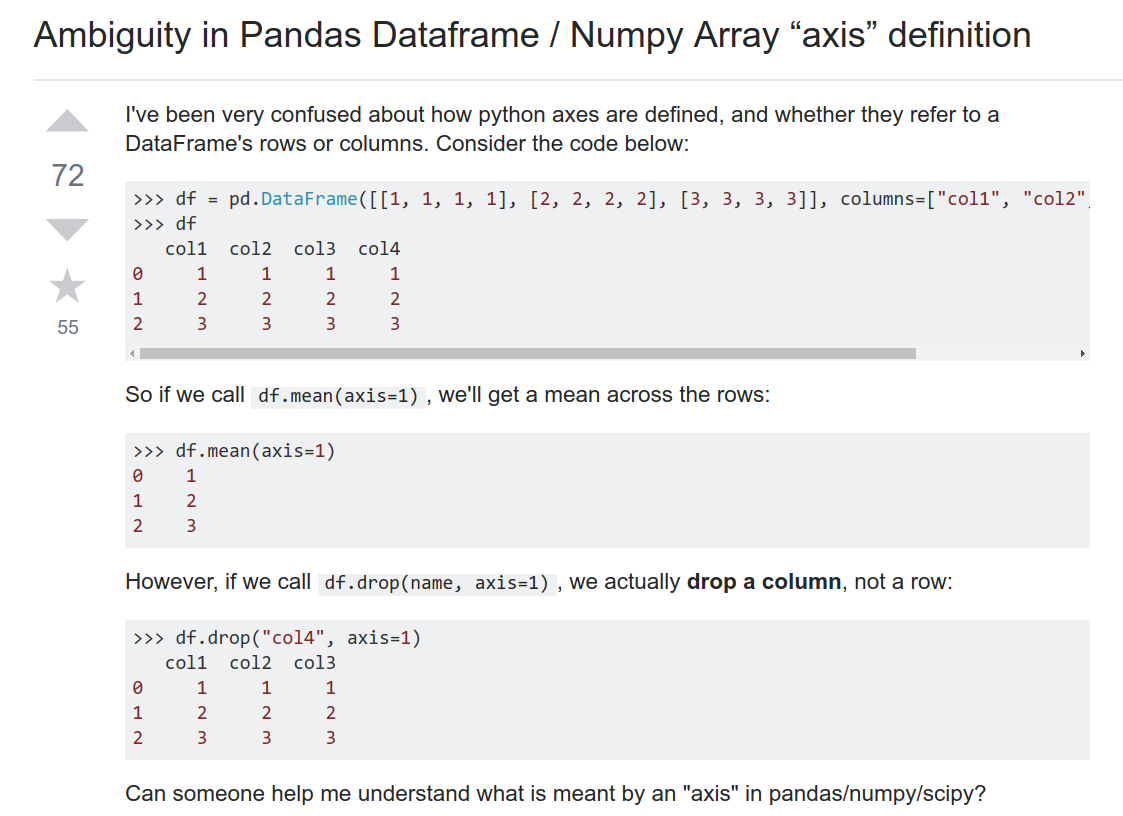Python 里 NumPy 的 axis 参数的理解
文章目录

最近学学 Python 做数据分析,主要就是 Python 基本语法 + NumPy + pandas 咯。
发现很好的一些教程:
果然人生苦短,大家都在用 Python。好教程都一搜一大把。然后今天在 B 站看莫烦的视频,前面都是讲 NumPy 的,array 这个东西其实对于我来说没那么重要,所以我就 1.5x 倍速的看。然后一边刷酷安和饭否啥的,基本没怎么操作,想着泛泛地听一听得了,后面 pandas 再认真听跟着操作。印象中 Python 里对于二维数据就是 0 是行 1 是列。因为我记忆的方法一直是我们平时都会说行列行列,那 0101 不就是行列行列。看到对 array 讲求均数、最大最小值以及后面 np.split() 发现一直有人在弹幕刷什么 axis = 0 是行有没有错或者怎么理解之类的。然后我就决定试一下看一看 (我都是在 conda 环境 IPython3 下面操作,所以前面都有 IN 和 OUT):
|
|
这样 a、b 分别是 3 行 4 列和 4 行 3 列的两个 array。print 看一下心里有底:
|
|
我们来看看求均数的时候 axis 参数怎么工作:
|
|
对 a 进行 “ 行求平均 ” 得到 4 个值,b 同样进行 “ 行求平均 ” 得到 3 个值。这不是列平均数吗? 对 a 进行”列求平均“得到 3 个值,b 同样进行“列求平均”得到 4 个值。这不是列求平均吗?
然后我就开始查了,“Python numpy axis” 拿去 Google 一下,果然问这个问题的不少:
我们看一个 StackOverflow 上的问题:Ambiguity in Pandas Dataframe / Numpy Array “axis” definition:

这个人几乎问了和我一模一样的问题,NumPy 的 axis 到底咋回事?
下面的回答解释得很详细:
It’s perhaps simplest to remember it as 0=down and 1=across.
This means:
- Use
axis=0to apply a method down each column, or to the row labels (the index).- Use
axis=1to apply a method across each row, or to the column labels.It’s also useful to remember that Pandas follows NumPy’s use of the word
axis. The usage is explained in NumPy’s glossary of terms:Axes are defined for arrays with more than one dimension. A 2-dimensional array has two corresponding axes: the first running vertically downwards across rows (axis 0), and the second running horizontally across columns (axis 1). [my emphasis]
So, concerning the method in the question,
df.mean(axis=1), seems to be correctly defined. It takes the mean of entries horizontally across columns, that is, along each individual row. On the other hand,df.mean(axis=0)would be an operation acting vertically downwards across rows.Similarly,
df.drop(name, axis=1)refers to an action on column labels, because they intuitively go across the horizontal axis. Specifyingaxis=0would make the method act on rows instead.
什么意思呢?其实简单的理解办法就是:axis = 0 就是在列上上下方向应用一个方法,或者说是对 row index 作用;而 axis = 1 就是在行上左右方向作用,或者说是对列名。
在 NumPy 的文档里也说了,axis = 0 是垂直方向上对行在上下合并操作,axis = 1 在水平方向上在对列左右合并操作。所以呢,这就能理解了,我们说行列其实是说在哪个维度上来操作,0 在行上操作,那么列不动,行上下压缩没了;反之,1 在列上左右方向操作,那行不动,列一压缩都没了。
再回头看开头的例子:
|
|
能理解了吧。
再来看开头提到的 np.split 。这个函数接受 3 个参数,对谁做切割操作,分成几块,以及 axis 即怎么切。
现在 a 三行四列,b 四行三列。所以考虑切两块的话,a 左右切,在列上左右操作,axis 是 1。b 就是上下切两块,行上上下操作,所以 axis 是 0 。验证一下:
|
|
可以看到,代码确实如我们所想的那样工作。
最后,我们再看 StackOverflow 上那个问题里提到的 df.drop("col4", axis=1) 也就能理解了,我们指定 axis = 1 即在列上左右操作,所以被 drop 掉的肯定是列,然后有参数指定哪些列就行了。
嗯,收工。图书馆刚好关门,晚安。
文章作者 Jackie
上次更新 2019-01-07 (4ea2787)